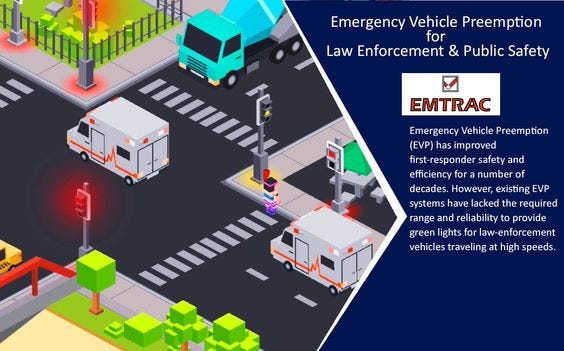Emergency Vehicle Preemption System (EVP) & Travel signal Priority (TSP)
Travel signal Priority (TSP) is an idea that has existed for quite a long time. The essential idea is that a travel vehicle (like a transport, trolley or light rail) passes over a transit specific detector at a decent point from a signalized convergence, and the traffic regulator at the crossing point runs an extraordinary program to propel the vehicle through the convergence all the more productively. This is commonly possibly set off when the vehicle is behind schedule and needs help to make up time.
Travel signal Priority System benefits:
- There are numerous different benefits to travel vehicle-to-foundation (T-V2I) collaboration. To begin with, the computer assessed time and distance estimations can change as conditions advance. In case the vehicle slows down or accelerates, it can send update messages to the traffic regulator to alter its ETA — the vehicle imparts at first and ‘checks in’. It then, at that point, consistently sends update status messages to the convergence until the time it elapses through the crossing point and ‘looks at’. Additionally, assuming the vehicle finds its timetable before it shows up at the convergence and at this point don’t need, it can drop its solicitation and resume ordinary activity.
- The adaptability of the real-time correspondences permits a single framework to be carried out in the most complicated travel frameworks. The vehicle, in view of its own settings, will realize what program on the traffic controller to demand. There could be various travel courses through a solitary convergence, extraordinary travel just developments (for instance, left turns for Vehicle’s) and travel just line bounces leaving transport stops.
- Having a shrewd framework that can demand the right program is basic. It likewise can’t be neglected that the communications work the two different ways. In the T-V2I model, the vehicle can get status data from the crossing point with the goal that it knows whether the convergence heard, comprehended and is following up on the needed demands.

Emergency Vehicle Preemption System
However, traffic Signals are intended to make more secure, more proficient junctions, they represent a peril for emergency response vehicles. Since the current length of the yellow light stage is generally founded on traveller vehicles, it is just about as much as 1.5 seconds more limited than the ideal length for fire engines and ambulances.
This puts those vehicles at more serious danger, particularly in case different drivers aren’t focusing, as indicated by the 2016 review by the National Institute for Occupational Safety. Obviously, the dangers are significantly more prominent when emergency response vehicles intentionally run red lights to save crucial time.
That is the place where Emergency Vehicle Preemption (EVP) frameworks come in. At the point when an emergency vehicle moves toward a traffic light, the EVP framework naturally changes the circumstance of the light cycle to guarantee a green light. This saves important seconds and secures crisis reaction vehicles, particularly as they enter a convergence from a minor street. Likewise, EVP frameworks influence similar gadgets as associated vehicles, including side of the road units (RSUs) and installed units (OBUs), which makes EVP frameworks considerably more financially savvy.
As per a FHWA report, “A survey of sign appropriation framework organizations in the United States shows diminishes accordingly times somewhere in the range of 14 and half for frameworks in a few urban communities. Framework costs will differ as per the measure of signalized crossing points and crisis reaction vehicles.



Comments
Post a Comment